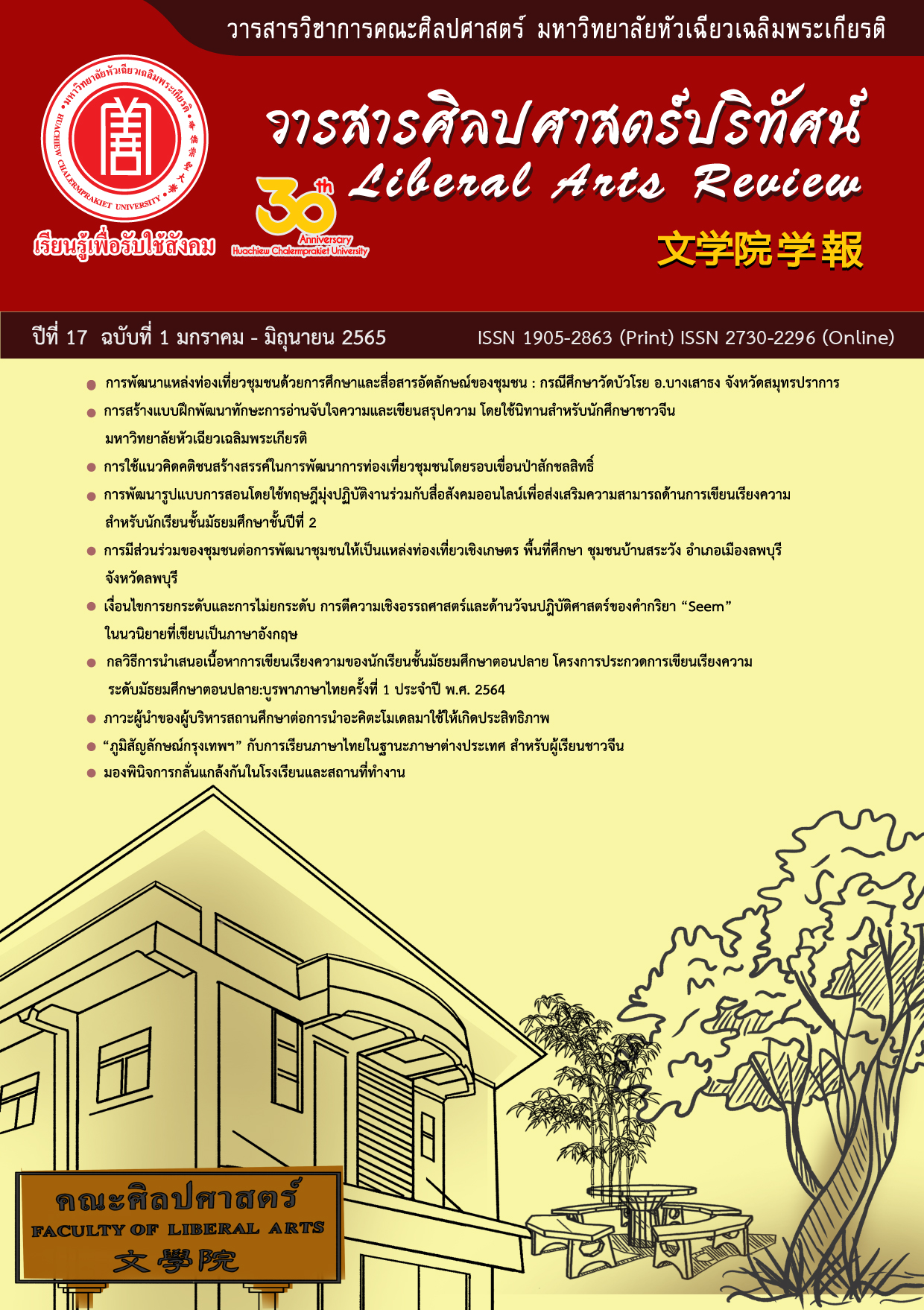Raised and Unraised Conditions, Semantic Interpretations and Pragmatic Aspects of the Verb “Seem” in English Novels
DOI:
https://doi.org/10.14456/lar.2022.6Keywords:
The verb seem, Raised and Unraised Conditions, Semantic Interpretations, English novelsAbstract
This study examined the syntactic structures of raised and unraised conditions, semantic interpretations and pragmatic aspects of the verb seem in English novels (i.e., Yes, Robert, I shall be ready: it seems to me that I ought to go). The previous studies in the field of the verb seem concentrated on the data collection of EFL learners. This study contributes to the field by examining English novels as Kusevska (2020) indicated that the verb seem occurs frequently in this text variety. The data of the verb seem in this study was gathered from Jane Eyre by Bronte (2018) and Emma by Austen (2020). They are the best-seller English novels (www.amazon.com). As a total of 450,000 words, there are 43 tokens, referring to sentences of both syntactic structures of raised and unraised conditions of the verb seem. In regard to the data analysis, the syntactic framework of raised and unraised conditions of the verb seem follows Radford (2009) where the theoretical analysis of the verb seem is classified into two camps: expletive it and non-expletive it. The semantic framework of the verb seem follows Song (2017) who classified the verb seem as epistemic modality, referring to evaluation, opinion and comment. The pragmatic aspects of analyzing the verb seem follow Merkin (2006) who explained the use of the verb seem as uncertainty avoidance and lack of enough information as supporting evidence. Regarding the data validation, three experts who are English instructors were asked to check the reliability and the accuracy of the data analysis. The results show that 74.42 percent of the verb seem in English novels comply with the raised condition. Their semantic interpretations were found to be comparison, advice and subjectivity. Pragmatically, the subject of the raising verb seem is an agent, referring to the one who performs an action which is raised to the initial position of the sentence in order to place emphasis. This current study will be beneficial for learners of English as a Foreign Language (EFL) and learners of English a Second Language (ESL) in order to study implicit learning of grammar of the verb seem.
References
Alias, M., Iksan, Z. H., & Karim, A. A. (2020). A novel approach in problem-solving skills using flipped classroom technique. Creative Education, 11(1), 38.
Austen, J. (2020). Emma. Missouri: Andrew McMeel.
Becker, M. (2005). Learning verbs without arguments: The problem of raising verbs, 34(2), 173-199.
Bronte, C. (2018). Jane Eyre. Missouri: Andrews McMell.
Chukwu, E. A. (2014). An overview of linking verbs (copulas) for the effective use of English. AJELLS, 5(1), 1-11.
Dixon, R. M. W. (2005). A semantic approach to English grammar. Oxford: Oxford University Press.
Du, A. (2011). A corpus-based study on use of copular verbs by Chinese school children learning English in China. I-manager’s Journal of English Language Teaching. 1(4). 33-39.
Fukulta, F. (2019). Selected copular verbs and their adjectival complements in contemporary written spoken English. Unpublished Thesis. Univerzita Karlova retrieved from https://dspace.cuni.cz/bitstream/handle/20.500.11956/112000/120343707.pdf?sequence=1.
Hayati, M., & Kalanzadeh, G. (2009). A contrastive study of English and Persian linking verb complementation. Retrieved from http://bibliotecavirtualut.suagm.edu/Glossa2/Journal/dec2008/A%20Contrastive%2 0Study%20of%20english.pdf.
Heng, C. S., & Tan, H. (2010). Extracting and comparing the intricacies of metadiscourse of two written persuasive corpora, International Journal of Education and Development using Information and Communication Technology, 6(3), 124-246.
Jean, G. & Simard, D. (2011). Grammar teaching and learning in L2: Necessary, but boring? Foreign Language Annals, 44(3), 467-494.
Kim, J. (2014). English copy raising constructions: Argument realization and characterization condition. Linguistics, 52(1), 167-203.
Koopman, H., & Sportiche, D. (1991). The position of subject. Lingua, 85, 211-258.
Kurnaz, S., & Karakaş, S. (2021). Sercan seems to Sena to be a Linguist! The raising construction in L2 English. ICU Working Papers in Linguistics (ICUWPL), 15, 35-44.
Kusevska, M. (2020). I can’t seem to find my glasses-the English verb seem and its Macedonean translation. Philological Studies, 18(2), 75-90.
Lopes-Couso, M., & Mendez-Nays, B. (2011). On the use of as if, as though and like in present Day-English complementation structures. Journal of English Linguistics, 40(2), 1-24.
Martínez Insúa, A. E. (2002). On the nature of the verb in present day English (existential) there-constructions. Formal and communicative implications. Revista Alicantina de Estudios Ingleses, 15, 133-152.
Merkin, R. S. (2006). Uncertainty avoidance and facework: A test of the Hofstede model. International Journal of Intercultural Relation, 20(2006), 213-228.
Radford, A. (2009). Introduction to English sentence structure. Cambridge: Cambridge University Press.
Rahman, A. M. A., & Rashid, R. A. (2017). Explicit and implicit grammar instructions in Higher learning institutions. English Language Teaching, 10(10), 92-101.
Song, M. (2017). A modal semantic approach to English evidential raising constructions. 언어와 정보, 21(1), 25-47.
Talal, R. (2017). A corpus-based analysis of the verb “seem”. Journal of Al-Nisour University College, 1(1). 1-10.
Teeranate, K., & Singhapreecha, P. (2022). Control before raising in Thai EFL grammar. LEARN Journal: Language Education and Acquisition Research Network, 15(1), 588-626.
Toneva, E., & Seizova-Nankova, T. (2014). The verb “seem”- A corpus-based approach. Studies in Linguistics, Culture and FLT, 1, 103-113.
Usoniene, A., & Šinkuniene, J. (2013). A cross-linguistic look at the multifunctionality of the English verb seem. Juana I. Marin-Arrese, Marta Carretero, Jorge Arus Hita, Johan van der Auwera (eds.). In English Modality: Core, Periphery and Evidentiality. Berlin/ DE Gruyter.
Wexler, K., & Hirsch, C. (2007). The late development of raising: what children seem to think about seem. Marcel den Dikken, Liliane Haegeman & Maria Polinsky (eds). In Studies in Natural Language and Linguistic Theory (pp. 35-70). Dordrecht: Springer.
Downloads
Published
How to Cite
Issue
Section
License
Copyright (c) 2022 Liberal Arts Review

This work is licensed under a Creative Commons Attribution-NonCommercial-NoDerivatives 4.0 International License.
บทความที่ได้รับการตีพิมพ์เป็นลิขสิทธิ์ของวารสารศิลปศาสตร์วิชาการและวิจัย
ข้อความที่ปรากฏในบทความแต่ละเรื่องในวารสารวิชาการเล่มนี้เป็นความคิดเห็นส่วนตัวของผู้เขียนแต่ละท่านไม่เกี่ยวข้องกับมหาวิทยาลัยหัวเฉียวเฉลิมพระเกียรติ และคณาจารย์ท่านอื่นๆ ในมหาวิทยาลัยฯ แต่อย่างใด ความรับผิดชอบองค์ประกอบทั้งหมดของบทความแต่ละเรื่องเป็นของผู้เขียนแต่ละท่าน หากมีความผิดพลาดใดๆ ผู้เขียนแต่ละท่านจะรับผิดชอบบทความของตนเองแต่ผู้เดียว




